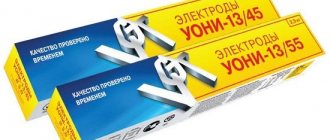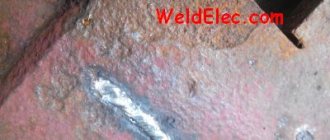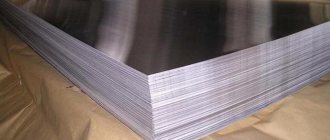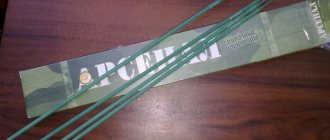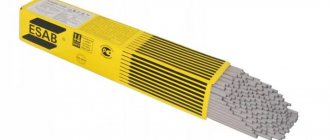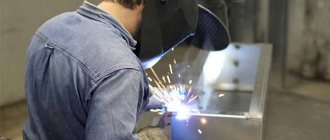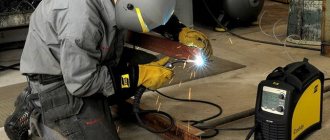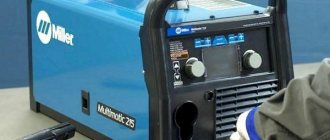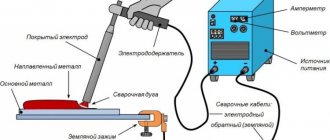Today's market for welding materials offers customers a large selection of electrodes.
Correctly selected welding material is a big contribution to the final success. Each type of electrical conductor is designed for use under certain conditions. In order to answer the question “How to choose electrodes for welding,” several factors should be determined:
- Metal thickness - the greater the thickness, the larger the diameter of the rod should be.
- Steel grade.
- Based on the electrode, you need to determine the type of current, and then the welding position.
Electrode selection criteria
Knowing the basic selection criteria will help you select suitable electrodes. The factors presented below influence the choice of a particular brand to varying degrees, but together they form a complete picture. So, the choice of welding materials is influenced by:
- the metal being welded - its type, type, thickness and the resulting requirements for the characteristics of the welded joint.
- the conditions in which the work is carried out and the further operation of structures and structures will take place.
- The experience and skill of the welder will affect the usability of certain grades.
- the quality of electrodes capable of providing the necessary characteristics of the weld metal.
Let's dwell on some factors and consider them in more detail.
Today there are a large number of metals and alloys, differing in their characteristics and areas of application. Therefore, it is important to select electrodes that ensure the production of weld metal similar in characteristics, mechanical properties and chemical composition to the base metal. This is achieved through the use of a special wire (core) and coating composition.
Among the main characteristics of metals are: strength, hardness, elasticity, ductility and toughness. For steels used in some industries, heat resistance, wear resistance and fatigue are also important. As a rule, on the packaging of products there is a brief description of what steels this or that brand is intended for.
Electrodes are distinguished according to their intended purpose: for manual arc welding of carbon and low-alloy steels, alloyed heat-resistant steels, high-alloy steels with special properties, cast iron, copper and alloys based on it; for manual electric arc surfacing of surface layers with special properties; for electric arc cutting.
The conditions of welding and operation of the connected structure also influence the choice. For welding in northern conditions, there are certain requirements for products. For example, GOODEL-52U electrodes are capable of operating at temperatures down to -50 degrees Celsius.
The thickness of the metal being welded affects the choice of product diameter. To connect parts of small thickness, small electrode diameters are used. This allows you to avoid burning and damage to the part. Accordingly, as the thickness of the workpiece increases, the diameter of the electrode also increases. And this in turn leads to an increase in the strength of the welding current, to ensure a greater depth of penetration. Today, electrodes of various diameters are produced, mainly from 2 to 6 mm. We will talk in more detail about how to choose the diameter of the electrode and the strength of the welding current depending on the thickness of the metal below.
Tip: if you don’t know or have forgotten how to choose the welding current, you can look at the manufacturer’s recommendations on the packaging with the materials. As a rule, acceptable welding modes are indicated there.
The experience and skills of the welder also influence the choice of brand. There are a number of different classifications other than ranks. For example, certification by NAKS for access to certain types of welding work. The more experienced the welder, the easier it is for him to weld with different types of electrodes. Beginners are recommended to start with rutile-type consumables and, after mastering them, begin practice with products of the basic type. This is due to the fact that basic electrodes require certain skills and dexterity, but once mastered they give excellent results. High weld quality and resistance to the formation of crystallization cracks; such electrodes also have a low hydrogen content.
The quality of welding materials directly affects the characteristics of the welded joint and the welding process itself. It is necessary to choose electrodes from reliable manufacturers who guarantee the quality of their products. You should also beware of counterfeits of some popular brands. As a rule, you can distinguish the original from the counterfeit by carefully examining the pack. Real packaging will always be of better quality: denser, more airtight, without obvious violations of integrity and traces of “crooked” gluing. You can also check the electrode itself. If the coating is not of a uniform color or has an uneven application, with a lot of chips, then you should think about it before buying such a pack. In any case, before purchasing, you should read several articles on this topic.
Manual arc welding technique
Electrode trajectory
- Proper arc maintenance and movement is the key to quality welding. An arc that is too long promotes oxidation and nitriding of the molten metal, spatters its droplets and creates a porous weld structure. A beautiful, even and high-quality seam is obtained with the correct choice of arc and its uniform movement, which can occur in three main directions.
- The forward movement of the welding arc occurs along the axis of the electrode. With this movement, the required arc length is maintained, which depends on the melting rate of the electrode. As the electrode melts, its length decreases, and the distance between the electrode and the weld pool increases. To prevent this from happening, the electrode should be moved along the axis, maintaining a constant arc. It is very important to maintain synchronicity. That is, the electrode moves towards the weld pool synchronously with its shortening.
- The longitudinal movement of the electrode along the axis of the welded seam forms a so-called thread welding bead, the thickness of which depends on the thickness of the electrode and the speed of its movement. Typically, the width of the thread welding bead is 2 - 3 mm larger than the diameter of the electrode. Strictly speaking, this is already a welding seam, only a narrow one. For a strong welding joint, this seam is not enough. And therefore, as the electrode moves along the axis of the weld, a third movement is performed, directed across the weld.
- The transverse movement of the electrode allows you to obtain the required seam width. It is performed by oscillatory movements of a reciprocating nature. The width of the transverse vibrations of the electrode is determined in each case individually and largely depends on the properties of the materials being welded, the size and position of the seam, the shape of the groove and the requirements for the welded joint. Typically, the width of the seam lies in the range of 1.5 - 5.0 electrode diameters.
- Thus, all three movements overlap each other, creating a complex trajectory of the electrode. Almost every experienced craftsman has his own skills in choosing the trajectory of the electrode, drawing intricate shapes with its end. Classic trajectories of electrode movement during manual arc welding are shown in Fig. 1. But in any case, the arc movement trajectory should be chosen in such a way that the edges of the parts being welded are fused to form the required amount of deposited metal and the specified weld shape.
- If the weld is not completed before the length of the electrode decreases so much that it requires replacement, then welding is stopped for a while. After replacing the electrode, remove the slag and resume welding. To complete a broken seam, strike an arc at a distance of 12 mm from the depression formed at the end of the seam, called a crater. The electrode is returned to the crater to form a fusion of the old and new electrodes, and then the electrode begins to move again along the originally chosen path.
Arc welding diagram
- The order of filling the seam along the cross-section and length determines the ability of the welded joint to absorb given loads and affects the magnitude of internal stresses and deformations in the seam mass.
- Seams are distinguished: short - the length of which does not exceed 300 mm, medium - 300 - 100 mm long and long - over 1000 mm. Depending on the length of the seam, its filling can be carried out according to various welding filling schemes, which are presented in Fig. 2.
- In this case, short seams are filled in one pass - from the beginning of the seam to its end. Medium-length seams can be filled using the reverse-step method or from the middle to the ends. To perform the reverse-step filling method, the seam is divided into sections whose length is 100-300 mm. In each of these sections, the seam is filled in the direction opposite to the general welding direction.
- If one pass of the welding arc is not enough to fill the seam normally, multilayer seams are applied. Moreover, if the number of applied layers is equal to the number of passes, the seam is called multilayer. If some layers are performed in several passes, such seams are called multi-layer-pass. Such seams are shown schematically in Fig. 3.
| Rice. 2. Arc welding schemes: 1 - pass welding; 2 - welding from the middle to the edges; 3 - reverse-step welding; 4 - block welding; 5 - cascade welding; 6 - welding with a slide | Rice. 3. Types of welds: 1 - single-layer; 2 - multi-pass; 3 - multi-layer, multi-pass |
- From the point of view of labor productivity, the most appropriate are single-pass welds, which are preferred when welding metals of small (up to 8-10 mm) thicknesses with preliminary cutting of the edges.
- But for critical structures (pressure vessels, load-bearing structures, etc.) this is not enough. Internal stresses arising during the welding process can cause cracks to appear in the weld or in the heat-affected zone due to insufficient ductility of the weld and high rigidity of the base metal. When welding products with relatively low rigidity, internal stresses cause local or general warping (deformation) of the structure being welded. In addition, when welding metals with a thickness of more than 10 mm. volumetric stresses appear and the risk of cracks increases. In such cases, a number of measures are taken to reduce stress and deformation: welds of a minimum cross-section, welding with multilayer seams, seams using “cascade methods” or “slide”, forced cooling or heating are used.
- When welding “slide”, first a first layer is laid at the base of the cut edges, the length of which should be no more than 200 - 300 mm. After this, the first layer is covered with a second one, the length of which is 200 - 300 mm longer than the first. The third layer is applied in the same way, overlapping the second by 200 - 300 mm. In this way, filling is continued until the number of layers in the area of the first seam is sufficient for filling. The next layer is applied at the end of the first layer, overlapping the last one (if the length of the seam allows) by the same 200 - 300 mm. If the first seam was laid not at the beginning of the seam, but in its middle part, then the slide is formed sequentially in both directions (Fig. 2, f). So, forming a slide, the entire seam is sequentially filled. The advantage of this method is that the welding zone is in a heated state all the time, which helps to improve the physical and mechanical properties of the seam, since internal stresses are minimal and the appearance of cracks is prevented.
- The “cascade method” of filling a seam is essentially the same “slide”, but it is performed in a slightly different sequence. To do this, the parts are connected to each other “on tacks” or in special devices. Lay the first layer, and then, stepping back from the first layer at a distance of 200 - 300 mm, lay the second layer, covering the area of the first (Fig. 2, e). Continuing in the same sequence, fill the entire seam.
- Fillet welds (Fig. 4) can be performed using two methods, each of which has its own advantages and disadvantages. When welding “in the corner,” a larger gap between parts is allowed (up to 3 mm), assembly is easier, but the welding technique is more complicated. In addition, undercuts and sagging are possible, and productivity is reduced due to the need to weld small-section seams with a leg less than 8 mm in one pass. Boat welding allows for larger seam legs in one pass and is therefore more productive. However, such welding requires careful assembly.
- The indicated arc welding techniques were considered at the lower positions of the seam, the implementation of which is the least labor-intensive. In practice, it is often necessary to perform horizontal seams on a vertical plane, vertical and ceiling welding. To perform these works, the same techniques are used as for seams with a lower position, but the labor intensity of the work and some technological features require a more detailed approach and changes in some methods.
- When welding such seams, there is a possibility of molten metal leaking out, which leads to drops falling to areas unfilled by welding, molten metal flowing along horizontal planes, etc.
| Rice. 4. Position of the electrode and the product when making fillet welds: A - symmetrical boat welding; B - in an asymmetrical “boat”; B - “in the corner” with an inclined electrode; G - with melted edges | Rice. 5. The influence of welding speed on the shape of the weld: With increasing speed, a noticeable decrease in the width of the weld is observed, while the depth of penetration remains almost unchanged. |
- Considering the essence of the processes occurring in such seams, we said that surface tension forces can hold the metal in a molten bath. In order for these forces to be sufficient, the welder must be masterful in welding techniques. Here it is necessary to reduce the welding current and use electrodes of reduced cross-section. This ultimately affects productivity as the number of welding passes has to be increased. Therefore, in practice, they try to add a “surface tension film” in addition to surface tension forces. The essence of this method is that the arc is not held constantly, but at certain intervals, that is, pulses.
- To do this, the arc is constantly interrupted, igniting it at certain intervals, allowing the molten metal to partially crystallize. It is here that the welder’s ability to choose such intervals is manifested when the welding leg does not have time to form and at the same time the metal would lose part of its fluidity.
- The ceiling seam is the most difficult. Therefore, conducting it with continuous arc burning is a futile task. Welding is performed by short-circuiting the arc to the weld pool so that it does not have time to cool, replenishing it with new portions of molten metal.
- When welding with this method, you should monitor the size of the arc, since its lengthening can cause unwanted undercuts. In addition, when welding such seams, unfavorable conditions are created for the release of slag from the molten metal, which can lead to porosity of the weld.
- Vertical seams can be welded in two directions - from bottom to top and from top to bottom. Both methods have a right to exist, but uphill welding is always preferable. In this case, the metal located below holds the weld pool, preventing it from spreading.
- When welding downhill, it is more difficult to hold the weld pool, and therefore it is much more difficult to achieve a high-quality seam. The essence of this method is practically no different from ceiling welding, and it is used when upward welding is technologically impossible.
- Horizontal seams on a vertical plane also have their own characteristics. In these welds, it is particularly difficult to retain the weld pool at both edges of the parts being welded. To facilitate this process, the bottom edge is not beveled. In this case, a shelf is obtained that helps hold the molten weld pool in place. Pulse welding with short-term ignition of the arc is also appropriate here, as for ceiling seams.
- Welding slag is removed with a chipping hammer. To do this, wait until the workpiece has cooled down enough that it can be picked up by hand, press it firmly to the table and, with hammer blows directed along the seam, remove the slag covering the weld seam. After this, the seam is forged to relieve internal stress. To do this, the hammer head is deployed along the seam and forged along its entire length. Finish the cleaning with a stiff wire brush, moving it with sharp movements, first along the seam and then across it to remove the last remnants of slag.
| Rice. 6. The influence of the angle of inclination of the product on the shape of the weld: When welding uphill, a large depth of penetration is observed, as well as a large height of the bead. When welding downhill, on the contrary, the depth of penetration decreases and the height of the weld decreases. In this case, the width of the seam practically does not change. | Rice. 7. Influence of the position of the electrode on the shape of the weld: The figure shows that when welding with a backward angle, the penetration is deeper, and when welding with a forward angle, the width of the seam increases and the height of the bead decreases. |
| Rice. 8. The influence of welding speed on the shape of the weld: The position of the weld pool when the product, arc or electrode is tilted. Downhill welding, uphill welding, forward angle welding. | Rice. 9. The influence of preparing edges for welding in butt joints. |
| Rice. 10. Elements of a butt weld, fillet weld and bead on a plate: B - width of the weld; K - seam leg | Rice. 11. Influence of the welding current during welding: If the welding current is changed during welding, the parameters of the weld cross-section will change. At a lower current, the penetration depth increases and the weld bead increases. |
Types and types of electrodes for welding
There are different types of welding electrodes: non-consumable, uncoated consumable and coated consumable. For manual arc welding, coated consumable electrodes are used. They, in turn, according to GOST 9466-75, have several types of coating. Let's look at the most common of them.
Electrodes with basic coating
One of the most popular types. In the marking they are designated by the letter “B”. They have good welding and technological properties. Provide high strength and toughness of the weld metal. They contain a small amount of hydrogen and provide resistance to alternating loads and low temperatures. Used for welding particularly critical structures, including oil and gas pipelines in northern conditions. Widely used in bridge construction and shipbuilding. Among the disadvantages: when welding, a relatively large amount of slag is produced, and when working with a long arc, pores can form in the seam. The surface of the elements to be welded must be degreased and cleaned. Products with this type of coating operate on direct current of reverse polarity. The most common brand is UONI-13/55.
Rutile coated electrodes
The second most popular are products with rutile coating. They are designated by the letter "P". The main advantages are simple ignition, stable arc burning, minimal spattering and easy slag separation. Coated electrodes of this type provide the ability to weld in any spatial position, as well as on contaminated and oxidized surfaces. Moreover, they can operate on direct and alternating current. These consumables are well suited for welding carbon and low-alloy steels. The most common brands are: OK-46, MR-3, OZS-12, ANO-21. It should be taken into account that before starting welding, the electrodes must be calcined.
In addition, there are electrodes with acid coating (A), cellulose coating (C), as well as various mixed types. For example, rutile cellulose (RC) or rutile acid (AR) and others. However, these types are less common.
additional characteristics
Many other features of the welding carried out determine the requirements for electrodes. An example is the polarity and type of current. The welding inverters used in most cases supply direct current, which can be supplied to the welding zone according to two schemes:
- Reverse polarity involves connecting the plus to ground and the minus to the electrode.
- Straight polarity. In this case, the plus is connected to ground, the minus to the welding electrode.
Reverse polarity is selected in the following cases:
- In order to protect the metal from burn-through, the reverse polarity of the connection is selected. It allows you to work with parts that are small in thickness.
- High-alloy steels are characterized by high susceptibility to heat. That is why, when working with such material, the reverse polarity connection method is chosen.
The most important parameters of the welding process are:
- Diameter of the electrodes used.
- The strength of the welding current used.
- The thickness of the parts to be connected.
It is very important to select the electrode diameter correctly, since if the value is too high, the welding current density is significantly reduced. In this case, the degree of penetration of parts decreases, the width of the weld seam increases and its quality decreases. In addition, manufacturers often indicate what amperage the product is best suited for.
This is interesting: Inch thread: size table, markings, GOST
Which electrodes to choose for welding metal structures
The choice of product type is also influenced by the type of metal being welded and what work is planned to be performed. Below is a table of recommended brands of electrodes produced by the GOODEL welding materials plant, depending on the purpose of the metal to be welded or surfaced.
| Purpose | Recommended Brands |
| Carbon and low alloy steels | OZS-4, MR-3, ANO-4, GOODEL-OK46, OZS-6, OZS-12, OZS-21, MR-3S, ANO-21, ANO-6, ANO-25, UONI-13/45, UONI-13/55U, UONI-13/65, UONI-13/85, TsU-5, VP-6 |
| Structures operating at subzero temperatures and alternating loads | UONI-13/55, ANO-11, GOODEL-OK48 |
| Pipeline welding | GOODEL-52U, TMU-21U |
| High alloy stainless steels | OZL-7, OZL-8, TsL-9, TsL-11, NZh-13, OZL-17U, EA-400/10, EA-395/9, NIAT-1, NIAT-5 |
| Heat-resistant and heat-resistant high-alloy steels | OZL-6, TsT-15, TsT-28, OZL-25B, ANZHR-1, ANZHR-2 |
| Welding of dissimilar steels (low alloy with chromium-nickel austenitic steels) | NII-48G |
| Welding and surfacing of gray and ductile cast iron and welding of cast iron defects | SHEZ-Ch1, OZCh-1, OZCh-2, OZCh-6 |
| Cold welding of structures made of ductile iron with nodular graphite and gray cast iron with flake graphite | TsCh-4 |
| Welding, surfacing and welding of defects in cast iron parts made of gray, malleable and high-strength cast iron | MNC-2 |
| Welding copper and bronze | Komsomolets-100, ANC/OZN-3; OZB-2M (for bronze) |
| Electric arc surfacing | OZSh-1, OZSh-3, VSN-10, OZN-300M, OZN-400M, OZN-6, OMG-N, EN-60M, OZN-7, OZN-7M, NR-70, TsN-6L, TsN- 12M, SHEZ-N13, 13KN/LIVT, T-590, T-620, TsNIIN-4, UONI-13/NZH 20Х13 |
| Surfacing of surfaces of forging equipment and parts of metallurgical equipment | OZSh-6, OZSh-8 |
| Surfacing of cold and hot stamping dies operating with heating of contact surfaces up to 650 °C | OZI-3 |
| Alloy heat-resistant steels | TML-1U, TML-3U, TsL-39 |
Advantages of popular brands of electrodes
Many modern types of electrodes for welding using an inverter have the following advantages.
- Easy to weld. Difficulties when welding with such electrodes can arise if you incorrectly select them according to the composition of the core material.
- High quality seam. This parameter is the most important during welding work, and the electrodes of the indicated brands make it possible to ensure it. Using such electrodes for the inverter, you can obtain high-quality internal and external connections, welds of convex and concave shapes.
- Easy slag separation. The slag obtained when welding using such electrodes is easily separated, which makes it possible to immediately see what quality of weld they provide.
- Corroded parts can be welded. Of course, products covered with a layer of rust are cooked very rarely, but these electrodes make it possible to obtain a high-quality and reliable seam even in this case.
- The welding process is safe for the welder in terms of sanitary and hygienic standards.
Electrodes of the ANO brand from the famous manufacturer ESAB
Selecting the electrode diameter depending on the thickness of the metal being welded
As a rule, the diameter can be selected based on the thickness of the metal of the product. As mentioned above, the greater the thickness of the metal, the larger the diameter of the electrode should be. It is worth noting that the choice of diameter is influenced not only by the thickness of the metal, but also by its properties. Basic recommendations for choosing the electrode diameter.
- For parts with a thickness of 1.5 to 2 mm, a Ø 2 mm electrode is suitable.
- To connect workpieces 3 mm thick, electrodes Ø 2.5 or 3 mm are suitable.
- If the thickness of the parts to be welded is from 4 to 5 mm, products with a diameter of 3 or 4 mm should be used.
- For structures with a thickness of 6 to 12 mm, it is best to choose electrodes Ø 4 or 5 mm.
- If the thickness of the elements to be welded exceeds 13 mm, then products with a diameter of 5 or 6 mm should be used.
When the workpiece thickness is less than 1.5 mm, manual welding, as a rule, is not used.
What is an electrode: device
This is a rod made of metal or other electrically conductive composition. It ensures the supply of current from the device to the object that requires welding. The elements come in different lengths: from 25 to 45 cm. Each of them has a protective coating. It prevents the oxidation process. Only a small part of the consumable remains “bare” - the part that is inserted into the holder. Therefore, when searching for components, it is important to consider their thickness. Three-millimeter ones are considered the most popular. Options of 1 and 2 mm are less popular among specialists. Thin ones are used with steel sheets and other parts that require a jewelry approach. You can easily find five-millimeter elements in stores, but beginners rarely need them. Rods with an end larger than 3 mm are needed for alloys that form thick sheets. To work with them, you need a high-power device, which not every beginner has. The variety of choices makes you wonder how to choose the right welding electrodes for an inverter and select their diameter according to the thickness of the metal for high-quality welding. We recommend that you be guided by the following principle: compare the values on the components and the material you plan to deal with. For example, for 2mm metal sheets, use 2mm rods.
Polarity and strength of welding current
Welding can be done with either alternating or direct current. For example, rutile electrodes can operate on both direct and alternating current, while consumables with a basic coating can only operate on direct current of reverse polarity.
When carrying out work using direct current, there are two connection options:
- When working on direct current of straight polarity, the workpiece to be welded is connected to the “+” terminal, and the electrode to the “–”.
- When using direct current of reverse polarity, the workpiece is connected to the “–” terminal, and the electrode holder to the “+”.
It should be taken into account that more heat is generated at the “+” contact. This means that it is better to weld massive parts using direct polarity, and thin sheet metal and high-alloy steels using reverse polarity. Using direct current of reverse polarity will avoid burning through thin parts and overheating of high-alloy steels.
Correctly selected amperage greatly facilitates the welding process and allows you to avoid defects during operation. There is an unspoken rule that 20-30 Amperes of current are added per millimeter of electrode diameter. The choice of current strength is also influenced by the spatial position of the weld, the number of layers of the weld and the thickness of the metal. As a rule, manufacturers indicate a range of recommended welding current values on the packaging with electrodes. Approximate current settings:
| Electrode diameter | 2 mm | 2.5 mm | 3 mm | 4 mm | 5 mm | 6 mm |
| Current strength | 40-64 A | 65-80 A | 70-130 A | 130-160 A | 180-210 A | 200-350 A |
There is no single correct setting. As a rule, the welder sets the amperage based on his own experience and feelings, as well as the equipment used. The main thing is that during the welding process, sufficient penetration depth and free control of the weld pool are ensured.
Welding thin metal with an inverter: video, features
Unlike welding thick metal, a 1mm thick metal sheet cannot be subjected to high heat. If overheating occurs, the sheets become deformed and burn through. The electrodes are carried strictly along the seam in one direction, without deviating to the sides.
The second feature of welding thin sheet metal with an inverter is that it is necessary to use a short arc, because the work is carried out at low currents. The difficulty with this is that when separated from the metal, it can go out, and insufficient current strength will lead to lack of penetration.
If the edges of the product are butt welded, they must be carefully cleaned and processed, because contamination will make the welding process even more problematic.
Taking these features into account, as well as relying on detailed instructions, welding 1 mm thin metal with an inverter for beginners will not be a difficult process with a high-quality result.
Electrodes for pipe welding
Important factors influencing the choice of electrodes for pipe installation are the method of their connection (spatial welding position) and wall thickness (affects the choice of diameter). For welding oil and gas pipelines and high-pressure tanks, electrodes with a basic coating of the following brands are used: GOODEL-52U, UONI 13/55, TsU-5, TML-1U.
For welding water and heating pipes at home, rutile electrodes GOODEL-OK46, MP-3 and ANO-4 are suitable.
How is arc voltage measured?
Arc voltage measurement
arc voltage
value is determined directly with a voltmeter without the use of any sensors.
However, even in this case, it is necessary to take into account some features of measuring
this parameter of the welding process in order to perform it properly.
Interesting materials:
How many gas blocks are there in one pallet? How many gas blocks 600x300x200 are in a pallet? How much milk does one cow produce on average? How much does IVF cost on average? How much does it cost on average to print a photo? How much does the average punching bag weigh? How much does an average turkey weigh? How much does a cat weigh on average? How long to cook gherkins? How many watts is the Phytolamp?
For a beginner welder
The most suitable consumables for beginners when welding with an inverter are rutile-coated electrodes MP-3 and ANO-21. For welding stainless steel, you can use products of the OZL-8 and TsL-11 brands. Consumables UONI-13/55 with a basic coating are more difficult to master, but are capable of providing high-quality and durable seams.
Most often, novice welders are recommended to use MP-3 electrodes. They ensure that a decent quality seam is obtained even with little experience. This is achieved due to easy ignition of the arc and fairly simple control of the weld pool, as well as its good protection from oxygen. Possibility of welding on contaminated and oxidized surfaces. Another advantage is the ability to weld in any spatial position, except vertical from top to bottom. They can cook both on direct current when connected to inverters or rectifiers, and on alternating current using transformers.
The best welding electrodes with basic coating
Such rods are characterized by low oxidizing ability, and the resulting welding seam has a low content of hydrogen, oxygen, sulfur and phosphorus impurities. Therefore, it has good crack resistance.
Similar electrodes are used for welding hardening, deoxidized steels and multilayer structures.
ESAB UONII 13/55
92%
buyers recommend this product
See review▶
Electrodes can be used for welding in almost all spatial positions. The deposited metal is resistant to crystallization cracks and is almost completely free of hydrogen.
The rods have a diameter of 2 to 5 millimeters, which allows processing materials up to 8 mm thick.
The permissible calcination temperature before work is 350-400°C. To avoid the formation of pores, welding should be carried out with direct current using a short arc.
Advantages:
- wide range of sizes;
- welding from any position;
- seam strength;
- economical consumption.
Flaws:
- sticking at high current.
ESAB UONII 13/55 are designed for welding low-carbon or low-alloy steel. The ease of operation in any position and the reliability of the resulting seam allow the rods to be used effectively in cramped conditions.
Lincoln Electric SSSI 13/55
90%
buyers recommend this product
The main features of these consumables include low cost and increased service life.
Electrodes can be used when working with materials at sub-zero temperatures and high humidity levels and do not require special storage conditions.
The diameter of the rods is 4 millimeters, the maximum permissible welding current is 160 Amps. Their use is effective in any spatial position, which ensures ease of work with various structural elements.
Advantages:
- high impact strength;
- work at temperatures down to -40 °C;
- minimal splashing;
- stable arc burning.
Flaws:
- require long-term calcination.
Lincoln Electric UONI 13/55 is an excellent choice for arc welding of reinforcing, carbon and alloy steels. Recommended for work in difficult conditions or prolonged use in frosty weather.
PlasmaTec Monolith TsCh-4
88%
buyers recommend this product
A special feature of the electrodes is the ability to work in unfavorable conditions. During welding, a gas bubble appears around the arc, preventing water or dust from entering the joint.
The diameter of the rods is 3 mm. They are characterized by arc stability, low spatter, and ease of both initial and re-ignition. This ensures high weld quality and rapid slag separation.
Advantages:
- protection of the welding zone;
- straight seam;
- economical consumption;
- do not require calcination.
Flaws:
- not intended for vertical welding.
PlasmaTec Monolith TsCh-4 is used for professional welding of thin sheet metal. An excellent choice for tank or pipeline work.
Kobelco LB-52U
86%
buyers recommend this product
They are distinguished by high arc stabilization and large depth of material penetration. Due to the low hydrogen content, the resulting weld is resistant to cracking and has high impact strength.
The diameter of the electrodes is 3 mm, length 40 centimeters. The rods are used for welding metals corresponding to strength classes up to K54, K55-K60. Material processing can be carried out using both direct and alternating current.
Advantages:
- reliable connection;
- fast calcination;
- deep metal penetration;
- ease of slag separation.
Flaws:
- difficulty in re-ignition.
Kobelco LB-52U is suitable for reinforcing the back side of a weld. The rod will be useful for internal processing of pipelines or tanks.
6 Best Welding Generators
Types of welding machines
Welding machines are divided into 2 groups: household and professional. Household appliances are designed to operate from a standard 220 V network with a frequency of 50 Hz. The current strength usually does not exceed 200 A, and the continuous operation time is short. Such welders allow you to perform the necessary welding work in the home. Professional equipment is distinguished by higher current strength (they can produce a current of more than 200 A) and operating time. They can be powered from a 380 V network. Such devices are used in welding oil pipelines, on construction sites and in other industries. The main function of all welding machines is to provide alternating or direct current.
There are several types of welding machines: transformers, rectifiers and inverters.
Transformers convert high voltage alternating current into lower voltage alternating current. The disadvantage of transformers is the inability to obtain a stable arc, as well as their large dimensions and weight. They are sensitive to power surges, and experience is required for successful operation. As a rule, they are used for rough welding of cheap steels.
Rectifiers convert alternating current to direct current. They allow you to get a stable arc and ensure a high-quality seam. They can cook stainless steel and aluminum, as well as low-alloy steels.
Inverters are the most popular welding machine nowadays. It has fairly high power with small dimensions and weight. They are functional and easy to use. They ensure stable arc burning and do not sag during power surges in the network. They can weld thin-walled metals. All types of electrodes are suitable for the inverter. Which electrodes for welding with an inverter are best to choose, read the article at the link.
Classification of consumables
| by appointment | designation | |
| for carbon and alloy structural steels with a tensile strength of up to 600 MPa | e38, e42, e42a, e46, e46a, e50, e50a, e55, e60 | at |
| for alloyed structural metals with a tensile strength of more than 600 MPa | e70, e85, e100, e125, e150 | l |
| for heat-resistant materials that have undergone alloying | e09m, e09mkh, etc. | T |
| welding of high-alloy parts with special properties | e12x13, e06x13m, e10x17t, etc. | V |
| surfacing of surface coatings with special characteristics | e10g2, e11gz, e16g2khm, etc. | n |
Identifying common groups among a great variety of options is a difficult task, which not all experienced craftsmen undertake. They are schematically divided according to their purpose, the chemical composition of the fused alloy, types, thickness, material from which they are made, and mechanical properties. Experienced specialists use those consumables that they are used to, or those that satisfy them in terms of price and quality ratio. When choosing, they usually take into account two criteria:
- The type of metal you will need to work with. If welding work is carried out at home, then most often we are talking about iron and alloys based on it - the so-called ferrous ones. In this case, the only thing a beginner should consider is the carbon content. Find out what kind of steel you will be dealing with: high, medium, low carbon or cast iron. Acquaintance also often has to start with “stainless steel”.
- Design requirements. Before deciding which electrodes to choose for inverter welding and how, it is necessary to understand whether the seams will be subject to vibration loads or temperature changes. In this case, you should pay attention to rods with enhanced properties.
Direct or alternating current
In order to correctly select electrode products, you need to know what type of current the welding process is possible with. In other words, what is better - “constant” or “change”? There are also universal brands that work on both types of current.
Electric welding with inverters using direct current has its own characteristics and advantages:
- There is practically no metal spattering (this saves electrodes);
- ease of use;
- high productivity due to reduced labor intensity;
- persistent and stable arc even in the presence of external negative influences: voltage fluctuations or gusts of wind;
- neat and high quality seam. There are no uncooked areas;
- ability to work with thin metal products.
There are also disadvantages:
- work is possible only with the use of expensive inverter technology;
- unstable arc in difficult places. For example, in the corners.
Two operating modes are possible: with direct or reverse polarity. The first option is used when working with thick metal and when high temperatures are required. Reverse polarity currents are convenient for connecting thin and low-melting metals, as well as dissimilar alloy and stainless steels.
Electric welding with alternating current does not require a rectifier. In addition, such electrodes are universal: they also work with direct current.
Minuses:
- worse connection quality than when using “permanent”;
- low impact strength;
- uneven seam;
- metal splashing.
Electrodes from foreign manufacturers
Electrodes of the ESAB brand have gained great popularity in the domestic market. A characteristic feature of electrodes from the Swedish manufacturer is that their marking begins with the designation “OK”, followed by 4 digits. Among the wide variety of electrode models of this brand, the following are the most widespread.
- OK 46.00. In terms of characteristics, they are very similar to domestic MP-3 products. Using an inverter, they can cook carbon and low-alloy steels using direct as well as alternating current. When used, the resulting connection is of high quality.
- OK 48.00. They can operate exclusively on direct current; they are used for the installation of particularly critical structures.
- OK 53.70. They are a specialized type; they are used to weld root passages and connect pipe joints.
- OK 61.30 and 63.20. They are used for welding stainless steel parts with an inverter, but before purchasing them, it is important to clarify whether they are suitable for working with the grade of metal you are interested in.
- OK 68.81. Using products of this brand, inverter welding is carried out on parts made of unspecified steel grades, as well as from difficult-to-weld grades.
- OK 96.20. They work on cast iron, and also connect cast iron parts to steel ones.
- OK 92.60. Designed for welding products made of aluminum and its alloys using an inverter.
By the way, the range of electrodes of this brand also includes products that can be used to weld copper and its alloys.
Types of welding arc when welding with electrodes
According to the requirements for the finished structure
The selection of electrodes for MMA welding depends on the requirements for the finished structure. It could be:
- tensile strength;
- impact strength;
- heat resistance;
- corrosion resistance;
- tensile strength;
- relative extension.
For example, for low-critical structures, a tensile strength of 43 kg/mm² is sufficient, and for products subject to increased loads, electrodes with a tensile strength of 55 kg/mm² are more suitable. Tensile strength is measured in MPa and can range from 380 to 650 or more MPa. Relative elongation is important under temperature changes and mechanical stress and can be 10-45%. Impact strength is measured in J/cm². The lower the temperature, the more fragile the joint becomes.
The resistance of a seam to corrosion is indicated in the marking of electrodes in 5 stages - the higher the number, the better. Heat resistance and heat resistance are indicated in 9 levels, each of which has its own temperature range. You can find out in more detail how to determine these indicators of electrodes by marking in the adjacent article. (here is a link to an article about marking that has not yet been published).
Scheme of electrodes compliance with GOST
In accordance with the GOST 9466–75 standard, electrodes are classified according to:
- purpose;
- thickness of the protective layer;
- chemical composition of the coating;
- permissible spatial orientations of seams;
- type of voltage and method of power connection (polarity).
Electrodes are classified according to their purpose and the thickness of the protective layer.
In accordance with the standard, there are electrodes for welding carbon steels that provide weld strength up to and above 600 MPa. Products are marked with the letters U and L. To work with heat-resistant alloy steels, products with the letter T are used. The letter B indicates products suitable for welding materials with a high content of chromium and nickel. Products with the designation N are used for surfacing. The numbers in the marking indicate the temporary tensile strength of the weld in kgf/mm² (for example, E42 provides a strength of at least 42 kgf/mm²).
To mark the thickness of the protective coating, the ratio of the diameters of the electrode and the wire rod is used, the letters M, C, D, G are entered into the code. An additional letter indicates the type of coating (for example, the base material is indicated as A, and the rutile coating is coded as P). Coating options comply with international ISO standards. Additional numbers in the code allow you to clarify the list of permissible spatial positions of seams and polarity when connecting direct voltage.
